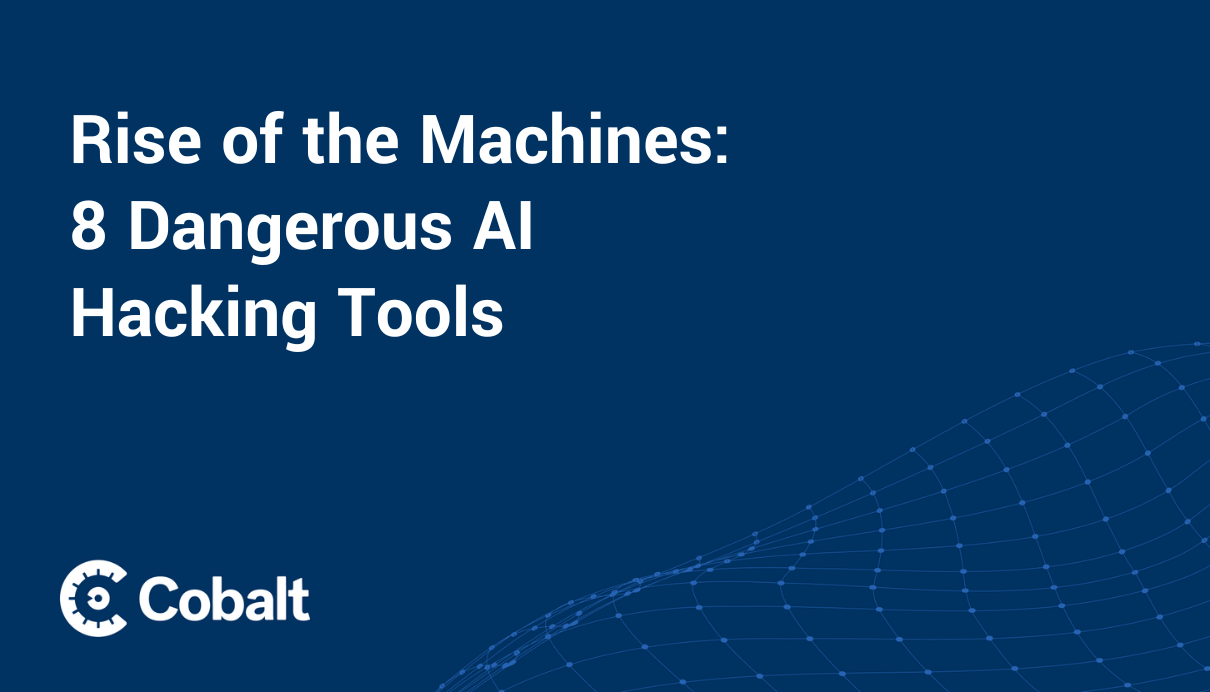According to the State of Pentesting Report 2024, a vast majority (86%) of respondents say they have seen a significant increase in the adoption of AI tools in the past year. From GitHub and Microsoft CoPilot to the flagship ChatGPT, and others — LLMs are transforming the internet today.
With this technological shift comes a ripple effect across nearly every industry today. The CEO of Google calls AI advancements more important than the invention of fire. So today we’ll explore the subject, how will AI affect cybersecurity?
Integrating artificial intelligence (AI) in cybersecurity offers the potential for enhanced defense strategies and the capability to predict attacks with notably quicker response times. As this technology continues to shape our daily lives, it’s helpful to understand the opportunities and emerging obstacles of combining AI with security.
Advantages of AI in cybersecurity: Exploring AI-enhanced cybersecurity measures
Implementing AI in cybersecurity has numerous benefits, with many arguing that the advantages outweigh the disadvantages.
Enhanced threat intelligence
Threat intelligence involves gathering, analyzing, and sharing information about potential or existing threats to help organizations protect themselves. It goes beyond collecting data and provides actionable insights to prevent or minimize cyber attacks.
AI, machine learning, and deep learning enhance cyber defense by transforming raw data into a robust security system.
Unlike traditional cybersecurity measures, AI operates proactively by analyzing large datasets and identifying patterns to predict and prevent attacks before they happen. This predictive capability allows cybersecurity teams to strengthen defenses and address vulnerabilities before exploitation.
AI's rapid analysis of extensive data sets empowers it to uncover correlations and patterns across diverse sources. It facilitates instant threat detection while substantially enhancing the threat intelligence database for future applications.
Machine learning algorithms can adapt based on new data and experiences, allowing AI-driven threat intelligence systems to refine and improve their detection and response mechanisms rapidly and continuously.
AI-driven systems are scalable, making them suitable for organizations handling large volumes of data and complex network environments without requiring a proportional increase in human resources.
AI-powered authentication
AI has the potential to revolutionize user authentication methods by incorporating advanced biometric analyses, behavior analysis, and other sophisticated techniques. By utilizing these methods, AI makes unauthorized access more difficult and ensures a frictionless experience for legitimate users.
This multifaceted approach enhances security by accurately verifying the user's identity through unique biometric markers such as fingerprints, facial recognition, or voice patterns. Additionally, behavioral analysis can detect abnormal patterns of interaction, adding an extra layer of security. This comprehensive authentication process strengthens security measures and provides a seamless and convenient user experience.
Automated response
AI systems are highly skilled at analyzing complex patterns and quickly identifying irregularities at speeds and scales that exceed human capabilities. This remarkable capability enables real-time detection of a wide range of threats, including malware infiltrations and suspicious activities within a network.
Once a threat is identified, AI-driven systems can promptly execute automated responses, such as isolating affected devices, blocking suspicious IP addresses, or deploying patches to address vulnerabilities—all within a fraction of a second. This swift and accurate reaction significantly boosts the defensive stance of organizations and reduces the possible effects of security breaches.
Enhanced Response Time
In the event of a cybersecurity incident, time is crucial. Systems fueled by AI, utilizing sophisticated algorithms and machine learning techniques, can swiftly sift through enormous datasets to pinpoint and counter threats faster and more precisely than solely human teams. This rapid response capability minimizes the window of opportunity for hackers to exploit vulnerabilities, reducing the potential impact of attacks. AI's efficiency in threat response is a vital asset in maintaining secure digital environments.
Scalability
As organizations expand, safeguarding their growing digital assets becomes increasingly challenging. AI excels in its capacity to scale alongside these increasing security needs. With AI, cybersecurity systems can adjust to monitor and protect larger networks without requiring proportional increases in human resources. This scalability is essential for maintaining strong security measures in rapidly growing digital environments.
Continuous Learning
AI and machine learning algorithms are created to learn from new data and experiences continuously. This allows AI-driven cybersecurity systems to become more intelligent and accurate over time, adjusting to new threats as they arise. This ongoing learning process guarantees that digital defenses stay strong and effective, even as cyber threats evolve.
Increase overall human speed and efficiency
Cybersecurity tasks often involve repetitive and time-consuming work, which makes them ideal for automation. AI can automate network traffic monitoring, search system logs for suspicious activity, and even initiate defensive protocols without human intervention. This speeds up response times and allows human resources to focus on complex problems.
Concerns About AI in Cybersecurity
Naturally, there are disadvantages of AI in cybersecurity that must be addressed. Each highlights the complexities and challenges of integrating AI technologies in this critical field.
Cobalt is leading the way with LLM security testing with multiple members of the Cobalt Core contributing to the OWASP LLM top 10. Further, our team of security experts uses our own internal findings to help define a new coverage checklist specific to LLM pentesting.
Privacy and Ethics
The primary function of AI in cybersecurity is to analyze vast datasets to detect anomalies and potential threats. This analysis involves sensitive personal and corporate data, which could lead to serious privacy violations and compromise individuals' personal information if mismanaged or inadequately protected.
Do users know what data is being collected and for what purpose? In many cases, the collection and usage of personal data for AI systems occur without explicit user consent and are often hidden in complex terms of service agreements. This blurs the notion of ownership and raises concerns about who has rights to an individual's digital footprint.
Even if collected with the best intentions for security, data repositories remain high-value targets for attackers. The irony is evident—the tools designed to protect may inadvertently become points of vulnerability themselves, leading to significant privacy breaches.
The use of AI for cybersecurity purposes inevitably blurs the line between diligent monitoring and intrusive surveillance. A system capable of detailed behavior analyses can monitor every digital action, tilting the scale toward a surveillance state and away from personal privacy.
AI operates on sophisticated algorithms and finely tuned machine-learning models that harness insights from diverse data sources. The potential for bias in these models is a pressing concern, not only in terms of fairness but also in the reliability and integrity of cybersecurity measures.
If the data used to train AI contains biases (intentional or unintentional), the AI will inevitably perpetuate and act upon these biases. In a cybersecurity context, this could result in unfair targeting or failure to protect specific demographics against cyber threats.
In addition to its functionality, the ethical use of AI involves considering the potential for malicious use. While designed for protection, AI algorithms are not immune to being reverse-engineered or repurposed for harmful activities such as deepfake generation or automation of hacking attempts, posing a significant threat if not properly regulated.
Hallucination
When discussing AI in cybersecurity, "hallucination" refers to a situation where an AI system generates false positives or perceives threats that don't exist. Hallucination can also refer to an AI misinterpreting data or patterns, leading to incorrect conclusions. This phenomenon is a byproduct of algorithmic errors, biases in the training data, or the AI's inability to adequately understand the complex and ever-changing nature of cybersecurity threats.
In essence, an AI hallucination in cybersecurity can be seen as a form of 'false alarm' where the AI system misidentifies benign activity as malicious or overgeneralizes from the inputs it has been given. Here's what it might mean for cybersecurity:
AI systems must be trained on diverse and representative data sets to prevent AI hallucinations in cybersecurity. They must also be rigorously tested and continuously monitored and updated by cybersecurity professionals to maintain their accuracy and reliability.
Lack of transparency or bias
The concerns about AI in cybersecurity also revolve around transparency and bias. The opaque AI decision-making processes, which may not be easily understandable to human operators, and the potential to perpetuate training data biases are significant issues. Transparency is crucial for understanding and managing AI systems, especially in sensitive areas like cybersecurity, as it allows for better oversight and accountability. Additionally, bias in AI systems is a considerable concern, as it can lead to unfair targeting and discrimination, potentially undermining the trust in these systems. Addressing these issues is essential for maintaining ethical standards and ensuring the effectiveness of cybersecurity AI systems in protecting against evolving threats.
High Initial Cost and Continued Maintenance
Finally, a complex financial equation lies beneath this technological marvel. Implementing and maintaining AI in cybersecurity is a significant investment, with costs that can quickly spiral if not carefully managed.
Operational costs can be significant, as AI systems require regular updates and maintenance to stay effective against evolving cyber threats. Training machine learning models on current threat data consumes substantial computational resources and time. Retraining AI models with new data as they improve also adds to operational expenses.
Additionally, the high-performance computing power needed to run AI algorithms comes with a significant energy cost that increases as the AI system scales. AI-driven cybersecurity solutions need frequent updates to keep pace with the latest threats, which may involve additional costs for support, implementation, and licensing fees.
The world of cybersecurity will undoubtedly undergo significant changes with the arrival of AI. These changes will be substantial and, overall, for the better. However, it’s important for anyone involved to understand both the positives and negatives, as they both exist.
Closing
In closing, AI is set to drastically disrupt the cybersecurity sector, enhancing aspects such as threat intelligence, scalability, or incident response — just to mention a few use cases. On the other hand, advancements in AI technology will also create novel challenges security professionals will need to overcome.
For companies building LLM-enabled applications, Cobalt offers services to help companies secure their AI applications and networks. Our team of experts includes first-hand experience testing LLM technologies and even members of the Cobalt Core who have contributed to OWASP's top 10 for Large Language Models.










